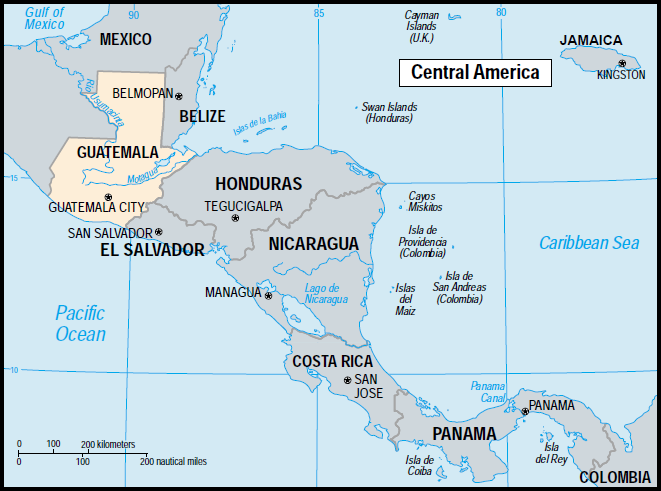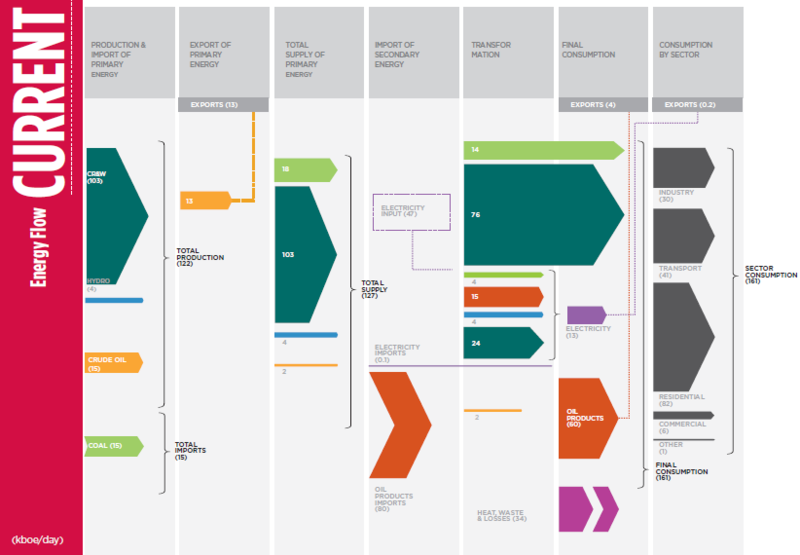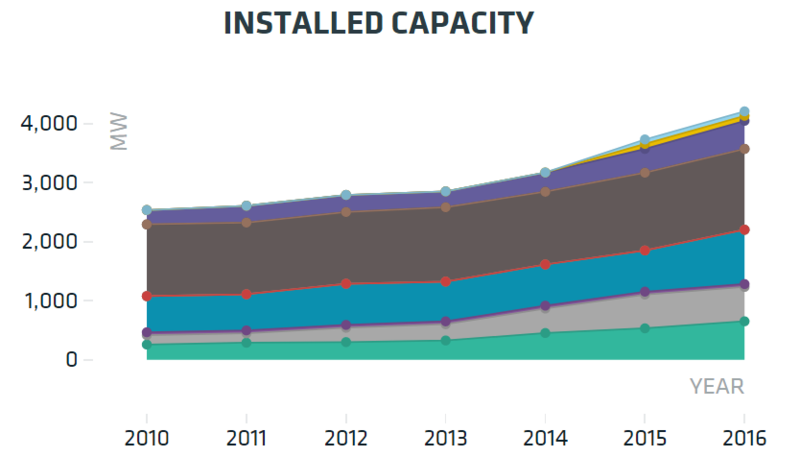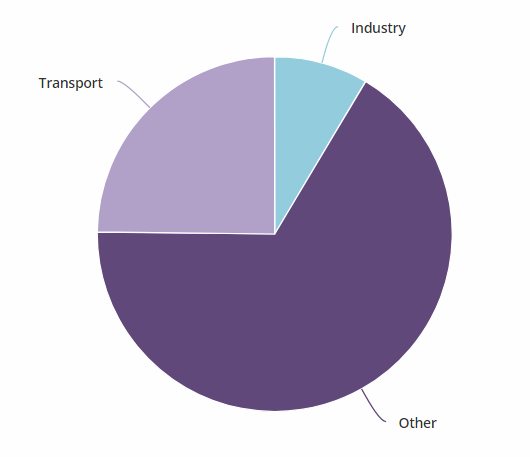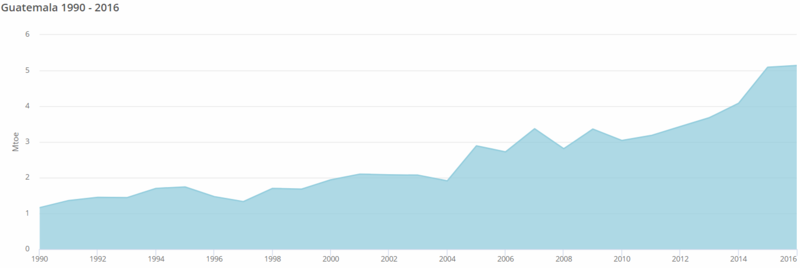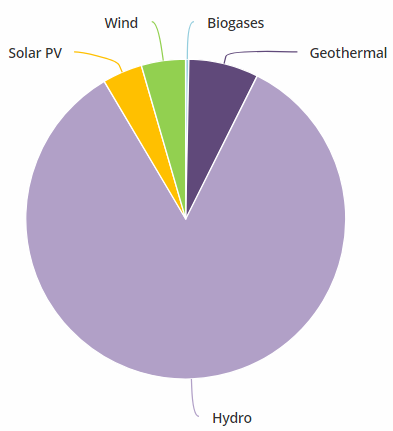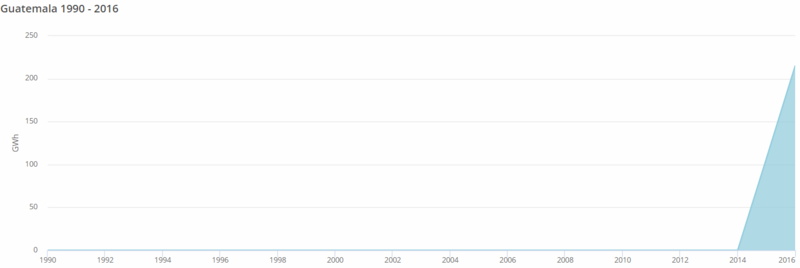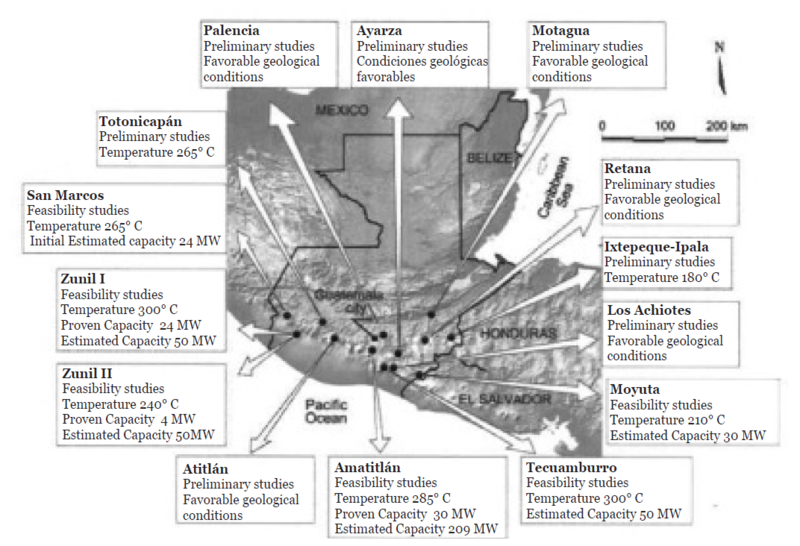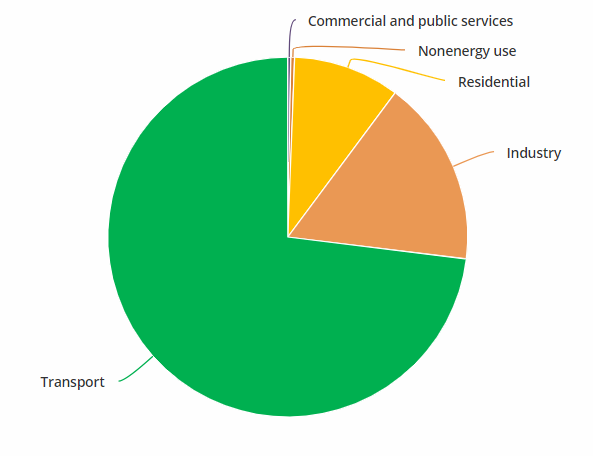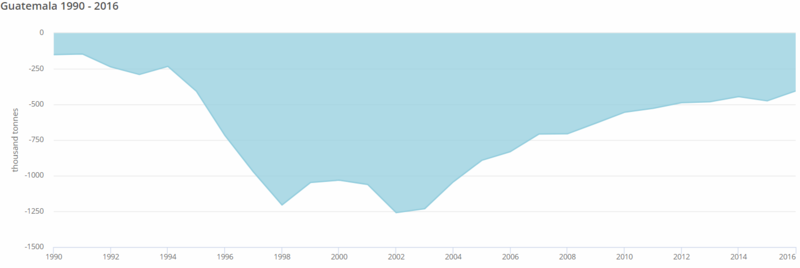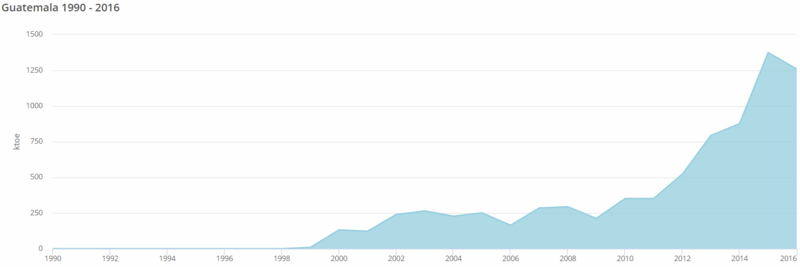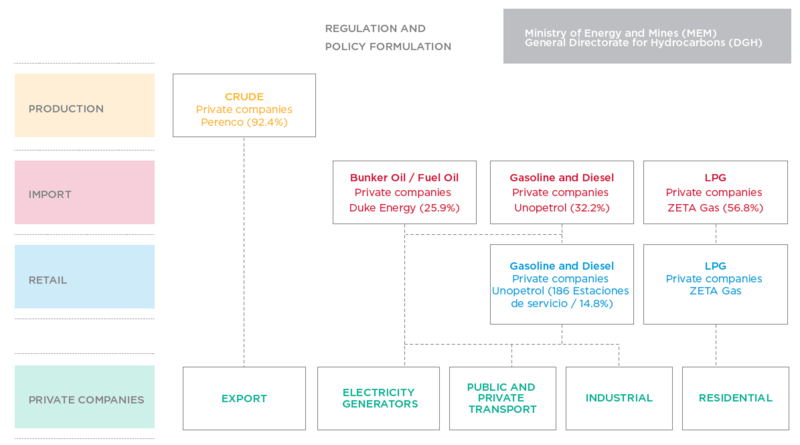Difference between revisions of "Guatemala Energy Situation"
***** (***** | *****) m |
***** (***** | *****) |
||
| (14 intermediate revisions by the same user not shown) | |||
| Line 594: | Line 594: | ||
<br/> | <br/> | ||
| + | |||
| + | Moreover, it is estimated that about 16 million cubic meters of wood are consumed <span style="font-size: 13.6px; background-color: rgb(255, 255, 255);">annually </span>in Guatemala<ref name="Ministry of Energy and Mines (MEM). (2015). Energy Policy 2013-2027. Retrieved From: http://www.mem.gob.gt/wp-content/uploads/2015/07/Energy-Policy-2013-2027.pdf">Ministry of Energy and Mines (MEM). (2015). Energy Policy 2013-2027. Retrieved From: http://www.mem.gob.gt/wp-content/uploads/2015/07/Energy-Policy-2013-2027.pdf</ref>. Another estimation that approximately 60-70% of households cooking with wood lack a sustainable fireplace for the extraction of the produced smoke<ref name="Ministry of Energy and Mines (MEM). (2015). Energy Policy 2013-2027. Retrieved From: http://www.mem.gob.gt/wp-content/uploads/2015/07/Energy-Policy-2013-2027.pdf">Ministry of Energy and Mines (MEM). (2015). Energy Policy 2013-2027. Retrieved From: http://www.mem.gob.gt/wp-content/uploads/2015/07/Energy-Policy-2013-2027.pdf</ref>. Finally, with accordance to the Economic Commission for Latin America and Caribbean (ECLAC), 72% of Guatemala's households use wood as energy source for cooking, which represents a major concern for health damage nation-wide<ref name="Ministry of Energy and Mines (MEM). (2015). Energy Policy 2013-2027. Retrieved From: http://www.mem.gob.gt/wp-content/uploads/2015/07/Energy-Policy-2013-2027.pdf">Ministry of Energy and Mines (MEM). (2015). Energy Policy 2013-2027. Retrieved From: http://www.mem.gob.gt/wp-content/uploads/2015/07/Energy-Policy-2013-2027.pdf</ref>. | ||
== Geothermal == | == Geothermal == | ||
| Line 682: | Line 684: | ||
Crude oil production in Guatemala has high potential, with estimations suggesting the possibility of reaching 50000 barrels/day<ref name="Ávalos, C. (2014). Invest in Guatemala: Energy and Oil – Industry in Guatemala. Retrieved From: http://www.investinguatemala.org/sites/default/files/2-energy-oil_eng.pdf">Ávalos, C. (2014). Invest in Guatemala: Energy and Oil – Industry in Guatemala. Retrieved From: http://www.investinguatemala.org/sites/default/files/2-energy-oil_eng.pdf</ref>. Main Guatemalan products in that regard are: ''''''heavy crude oil'''''' with API gravities 10-22.3 & ''''''bitter'''''' with Sulphur percentages > 1%<ref name="Ávalos, C. (2014). Invest in Guatemala: Energy and Oil – Industry in Guatemala. Retrieved From: http://www.investinguatemala.org/sites/default/files/2-energy-oil_eng.pdf">Ávalos, C. (2014). Invest in Guatemala: Energy and Oil – Industry in Guatemala. Retrieved From: http://www.investinguatemala.org/sites/default/files/2-energy-oil_eng.pdf</ref>. | Crude oil production in Guatemala has high potential, with estimations suggesting the possibility of reaching 50000 barrels/day<ref name="Ávalos, C. (2014). Invest in Guatemala: Energy and Oil – Industry in Guatemala. Retrieved From: http://www.investinguatemala.org/sites/default/files/2-energy-oil_eng.pdf">Ávalos, C. (2014). Invest in Guatemala: Energy and Oil – Industry in Guatemala. Retrieved From: http://www.investinguatemala.org/sites/default/files/2-energy-oil_eng.pdf</ref>. Main Guatemalan products in that regard are: ''''''heavy crude oil'''''' with API gravities 10-22.3 & ''''''bitter'''''' with Sulphur percentages > 1%<ref name="Ávalos, C. (2014). Invest in Guatemala: Energy and Oil – Industry in Guatemala. Retrieved From: http://www.investinguatemala.org/sites/default/files/2-energy-oil_eng.pdf">Ávalos, C. (2014). Invest in Guatemala: Energy and Oil – Industry in Guatemala. Retrieved From: http://www.investinguatemala.org/sites/default/files/2-energy-oil_eng.pdf</ref>. | ||
| + | |||
| + | <br/> | ||
| + | |||
| + | The Guatemalan petroleum products are mainly exploited for the purpose of heat generation for both industrial and transportation sectors<ref name="Ministry of Energy and Mines (MEM). (2015). Energy Policy 2013-2027. Retrieved From: http://www.mem.gob.gt/wp-content/uploads/2015/07/Energy-Policy-2013-2027.pdf">Ministry of Energy and Mines (MEM). (2015). Energy Policy 2013-2027. Retrieved From: http://www.mem.gob.gt/wp-content/uploads/2015/07/Energy-Policy-2013-2027.pdf</ref>. | ||
<br/> | <br/> | ||
| Line 870: | Line 876: | ||
*Addressing concerns with regard to the legal system for generation, transmission, distribution and marketing of electricity. | *Addressing concerns with regard to the legal system for generation, transmission, distribution and marketing of electricity. | ||
*Issuing mining exploitation policies | *Issuing mining exploitation policies | ||
| + | *Studying and promoting the use of renewables | ||
| + | *Trying to achieve energy self-sufficiency in the country | ||
| + | *Coordinating the actions necessary for maintaining an adequate, and efficient supply of oil, petroleum products and natural gas, with accordance to both the natioanl demand and the related laws | ||
| + | *Formulation of policies for the energy sector | ||
| + | *Proposing and enforcing environmental regulations on energy | ||
| + | *Issuing an opinion on the scope of its own jurisdiction over the policies and projects of other public institutions, in order to indicate the situation of the energy development in the country | ||
| + | *Exercising regulatory, control and suprvisory roles with relation to electricity and the laws governing it | ||
| + | |||
| + | <br/> | ||
| + | |||
| + | [http://www.mem.gob.gt/wp-content/uploads/2012/05/2.3-Ley-y-Reglamento-de-Incentivos-de-Energia-Renovables.pdf The Renewable Energy Projects Law (Decree 52-2003)] provides incentives for municipalities, The National Electrification Institute (INDE), joint ventures, individuals and legal entities to engage in renewable energy projects<ref name="Ávalos, C. (2014). Invest in Guatemala: Energy and Oil – Industry in Guatemala. Retrieved From: http://www.investinguatemala.org/sites/default/files/2-energy-oil_eng.pdf">Ávalos, C. (2014). Invest in Guatemala: Energy and Oil – Industry in Guatemala. Retrieved From: http://www.investinguatemala.org/sites/default/files/2-energy-oil_eng.pdf</ref>: | ||
| + | |||
| + | #Tax exemption for up to 10 years: Including the value added tax (VAT) for the machinery and equipment used in the project during the preliminary stage and construction | ||
| + | #Income tax exemption for up to 10 years | ||
| + | #Exemption of denominated tax on enterprise and agricultural businesses for a period up to 10 years | ||
| + | #Advertising the high potential of the sector, as approximately 3 million Guatemalan people still in need for electricity, implying investment opportunities of 500 million US$, with high return | ||
| + | |||
| + | <br/> | ||
| + | |||
| + | == The Hydrocarbons Sub-Sector == | ||
| + | |||
| + | *Regulated -mainly- by the Ministry of Energy and Mines (MEM)<ref name="Ávalos, C. (2014). Invest in Guatemala: Energy and Oil – Industry in Guatemala. Retrieved From: http://www.investinguatemala.org/sites/default/files/2-energy-oil_eng.pdf">Ávalos, C. (2014). Invest in Guatemala: Energy and Oil – Industry in Guatemala. Retrieved From: http://www.investinguatemala.org/sites/default/files/2-energy-oil_eng.pdf</ref> | ||
| + | *Other regulating institutions<ref name="Ávalos, C. (2014). Invest in Guatemala: Energy and Oil – Industry in Guatemala. Retrieved From: http://www.investinguatemala.org/sites/default/files/2-energy-oil_eng.pdf">Ávalos, C. (2014). Invest in Guatemala: Energy and Oil – Industry in Guatemala. Retrieved From: http://www.investinguatemala.org/sites/default/files/2-energy-oil_eng.pdf</ref>: Ministry of Environment and Natural Resources - The Protected Areas Commission | ||
| + | *The laws which established the different regulatory roles of these institutions<ref name="Ávalos, C. (2014). Invest in Guatemala: Energy and Oil – Industry in Guatemala. Retrieved From: http://www.investinguatemala.org/sites/default/files/2-energy-oil_eng.pdf">Ávalos, C. (2014). Invest in Guatemala: Energy and Oil – Industry in Guatemala. Retrieved From: http://www.investinguatemala.org/sites/default/files/2-energy-oil_eng.pdf</ref>: [https://digitalrepository.unm.edu/cgi/viewcontent.cgi?article=1244&context=la_energy_policies The Hydrocarbon Law (Decree 109-83)] - The Law for Commercialization of Hydrocarbons (Decree 109-97) - The Regulation for Invitations to submit offers to conclude oil exploration and exploitation contracts (Government Agreement 764-92) | ||
| + | *The Law for Fund for National Economic Development, which came into force in 2008, aims to distribute the raised funds by the oil operations as follows<ref name="Ministry of Energy and Mines (MEM). (2015). Energy Policy 2013-2027. Retrieved From: http://www.mem.gob.gt/wp-content/uploads/2015/07/Energy-Policy-2013-2027.pdf">Ministry of Energy and Mines (MEM). (2015). Energy Policy 2013-2027. Retrieved From: http://www.mem.gob.gt/wp-content/uploads/2015/07/Energy-Policy-2013-2027.pdf</ref>: 20% to the department development councils where petroleum operations are executed - 5% to all department development councils where there are no oil operations - 3% to public entities responsible for the conservation of protected areas | ||
| + | |||
| + | <br/> | ||
| + | |||
| + | == The Electricity Sub-Sector == | ||
| + | |||
| + | This sub-sector is defined and regulated as shown in the following table: | ||
| + | |||
| + | {| border="1" cellspacing="0" cellpadding="5" style="width:100%;" | ||
| + | |+ Table.17: The Main Regulators of the Electricity Sub-Sector in Guatemala<ref name="Ávalos, C. (2014). Invest in Guatemala: Energy and Oil – Industry in Guatemala. Retrieved From: http://www.investinguatemala.org/sites/default/files/2-energy-oil_eng.pdf">Ávalos, C. (2014). Invest in Guatemala: Energy and Oil – Industry in Guatemala. Retrieved From: http://www.investinguatemala.org/sites/default/files/2-energy-oil_eng.pdf</ref> | ||
| + | |- | ||
| + | ! scope="row" | Institution | ||
| + | ! scope="col" | Ministry of Energy and Mines (MEM) | ||
| + | ! scope="col" | The National Energy Commission | ||
| + | ! scope="col" | The Wholesale Market Administrator | ||
| + | |- | ||
| + | ! scope="row" | Role | ||
| + | | The policy maker | ||
| + | | The regulator | ||
| + | | | ||
| + | *The national operator of the interconnected national system | ||
| + | *Administrator of the national system 's transactions | ||
| + | |||
| + | |} | ||
| + | |||
| + | <br/> | ||
| + | |||
| + | *These three entities govern the whole sub-sector with all its<ref name="Ávalos, C. (2014). Invest in Guatemala: Energy and Oil – Industry in Guatemala. Retrieved From: http://www.investinguatemala.org/sites/default/files/2-energy-oil_eng.pdf">Ávalos, C. (2014). Invest in Guatemala: Energy and Oil – Industry in Guatemala. Retrieved From: http://www.investinguatemala.org/sites/default/files/2-energy-oil_eng.pdf</ref>: generators - transporters - distributors - large users - marketers. | ||
| + | *[http://www.mem.gob.gt/wp-content/uploads/2012/05/Reglamento-de-LGE.pdf The Electricity Law (Decree No. 93-96)] is the main governing framwork of the sub-sector<ref name="Ávalos, C. (2014). Invest in Guatemala: Energy and Oil – Industry in Guatemala. Retrieved From: http://www.investinguatemala.org/sites/default/files/2-energy-oil_eng.pdf">Ávalos, C. (2014). Invest in Guatemala: Energy and Oil – Industry in Guatemala. Retrieved From: http://www.investinguatemala.org/sites/default/files/2-energy-oil_eng.pdf</ref>, which states that the electricity generation in the country is free, and does not require state authorization<ref name="Ávalos, C. (2014). Invest in Guatemala: Energy and Oil – Industry in Guatemala. Retrieved From: http://www.investinguatemala.org/sites/default/files/2-energy-oil_eng.pdf">Ávalos, C. (2014). Invest in Guatemala: Energy and Oil – Industry in Guatemala. Retrieved From: http://www.investinguatemala.org/sites/default/files/2-energy-oil_eng.pdf</ref>. The authorization is only required, when the generation exceeds 5MW, which is then granted by the Ministry of Energy and Mines<ref name="Ávalos, C. (2014). Invest in Guatemala: Energy and Oil – Industry in Guatemala. Retrieved From: http://www.investinguatemala.org/sites/default/files/2-energy-oil_eng.pdf">Ávalos, C. (2014). Invest in Guatemala: Energy and Oil – Industry in Guatemala. Retrieved From: http://www.investinguatemala.org/sites/default/files/2-energy-oil_eng.pdf</ref>. | ||
| + | *Further important laws forming the legal framwork in the sub-sector<ref name="Ávalos, C. (2014). Invest in Guatemala: Energy and Oil – Industry in Guatemala. Retrieved From: http://www.investinguatemala.org/sites/default/files/2-energy-oil_eng.pdf">Ávalos, C. (2014). Invest in Guatemala: Energy and Oil – Industry in Guatemala. Retrieved From: http://www.investinguatemala.org/sites/default/files/2-energy-oil_eng.pdf</ref>: Regulation of the Wholesale Market Administrator (Governmental Agreement 299-98) - Social Tariff Law for Electric Power Supply (Decree 96-200) - The Law of Incentives for the Development of Renewable Energy Projects (Decree 53-2003). | ||
| + | |||
| + | <br/> | ||
| + | |||
| + | == The Energy Policy 2013-2027 == | ||
| + | |||
| + | *The Guatemalan energy sector is formed entirely by two main sub-sectors: hydrocarbons & electricity<ref name="Ministry of Energy and Mines (MEM). (2015). Energy Policy 2013-2027. Retrieved From: http://www.mem.gob.gt/wp-content/uploads/2015/07/Energy-Policy-2013-2027.pdf">Ministry of Energy and Mines (MEM). (2015). Energy Policy 2013-2027. Retrieved From: http://www.mem.gob.gt/wp-content/uploads/2015/07/Energy-Policy-2013-2027.pdf</ref> | ||
| + | *The policy prioritizes the use of clean and environmentally friendly energy resources for national consumption<ref name="Ministry of Energy and Mines (MEM). (2015). Energy Policy 2013-2027. Retrieved From: http://www.mem.gob.gt/wp-content/uploads/2015/07/Energy-Policy-2013-2027.pdf">Ministry of Energy and Mines (MEM). (2015). Energy Policy 2013-2027. Retrieved From: http://www.mem.gob.gt/wp-content/uploads/2015/07/Energy-Policy-2013-2027.pdf</ref> | ||
| + | *The policy urges an interagency dialogue for conducting democratically social and economic development initiatives, which aim to ensure a comprehensive approach in the implementation, monitoring and evaluation of the public policy<ref name="Ministry of Energy and Mines (MEM). (2015). Energy Policy 2013-2027. Retrieved From: http://www.mem.gob.gt/wp-content/uploads/2015/07/Energy-Policy-2013-2027.pdf">Ministry of Energy and Mines (MEM). (2015). Energy Policy 2013-2027. Retrieved From: http://www.mem.gob.gt/wp-content/uploads/2015/07/Energy-Policy-2013-2027.pdf</ref> | ||
| + | *The policy aims to contribute to Guatemala's sustainable energy development with both<ref name="Ministry of Energy and Mines (MEM). (2015). Energy Policy 2013-2027. Retrieved From: http://www.mem.gob.gt/wp-content/uploads/2015/07/Energy-Policy-2013-2027.pdf">Ministry of Energy and Mines (MEM). (2015). Energy Policy 2013-2027. Retrieved From: http://www.mem.gob.gt/wp-content/uploads/2015/07/Energy-Policy-2013-2027.pdf</ref>: social equity & respect to the environment | ||
| + | *The policy is divided into two main frameworks, which are represented in the following table: | ||
| + | |||
| + | {| border="1" cellspacing="0" cellpadding="5" style="width:100%;" | ||
| + | |+ Table.18: Guatemala's Energy Policy 2013-2027's Main Frameworks<ref name="Ministry of Energy and Mines (MEM). (2015). Energy Policy 2013-2027. Retrieved From: http://www.mem.gob.gt/wp-content/uploads/2015/07/Energy-Policy-2013-2027.pdf">Ministry of Energy and Mines (MEM). (2015). Energy Policy 2013-2027. Retrieved From: http://www.mem.gob.gt/wp-content/uploads/2015/07/Energy-Policy-2013-2027.pdf</ref> | ||
| + | |- | ||
| + | ! scope="row" | Framework | ||
| + | ! scope="col" | General Framework | ||
| + | ! scope="col" | Strategic Framework | ||
| + | |- | ||
| + | ! scope="row" | Summary | ||
| + | | | ||
| + | *Provides information on the energy sector's status and its corresponding sub-sectors | ||
| + | *Addresses the concerns which are considered for the policy actions and objectives<br/> | ||
| + | *Includes the legal and political framework, guiding principles and approaches<br/> | ||
| + | *It develops the theoretical and conceptual underpinning vision for the medium and long teram sustainable development actions | ||
| + | |||
| + | | | ||
| + | *Contains policy's main points, comprising objectives, strategic priorities, goals, actions and public institutions related to the energy sector | ||
| + | *Reflects the interventions required for achieving objectives | ||
| + | |||
| + | |} | ||
| + | |||
| + | *The energy policy 2013-2027 is based on the following laws and decrees<ref name="Ministry of Energy and Mines (MEM). (2015). Energy Policy 2013-2027. Retrieved From: http://www.mem.gob.gt/wp-content/uploads/2015/07/Energy-Policy-2013-2027.pdf">Ministry of Energy and Mines (MEM). (2015). Energy Policy 2013-2027. Retrieved From: http://www.mem.gob.gt/wp-content/uploads/2015/07/Energy-Policy-2013-2027.pdf</ref>: | ||
| + | |||
| + | #Law of Hydrocarbons (Decree 109-86) | ||
| + | #Law of Protected Areas (Decree 9-89 of the Congress of the Republic of Guatemala) | ||
| + | #Law of Electricity (Decree 93-96) | ||
| + | #Law of Hydrocarbon Commercialization (Decree 109-97) | ||
| + | #Law of Urban and Rural Development Coucils (Decree 11-2002) | ||
| + | #Municipal Code (Decree 12-2002) | ||
| + | #General Law of Decentralization (Decree 14-2002) | ||
| + | #Law of the Fund of National Economic Development (Decree 71-2008) | ||
| + | #Regulation of Environmental Impact Studies | ||
| + | |||
| + | *The policy is as well aligned with a number of international conventions , which are related to the energy sector, in addition to the national legal and policy framework<ref name="Ministry of Energy and Mines (MEM). (2015). Energy Policy 2013-2027. Retrieved From: http://www.mem.gob.gt/wp-content/uploads/2015/07/Energy-Policy-2013-2027.pdf">Ministry of Energy and Mines (MEM). (2015). Energy Policy 2013-2027. Retrieved From: http://www.mem.gob.gt/wp-content/uploads/2015/07/Energy-Policy-2013-2027.pdf</ref>. | ||
| + | |||
| + | <br/> | ||
| + | |||
| + | === Important International Conventions === | ||
| + | |||
| + | On the international level, the State of Guatemala has signed and ratified several legal instruments for: environmental regulations, the protection of social and economic rights<ref name="Ministry of Energy and Mines (MEM). (2015). Energy Policy 2013-2027. Retrieved From: http://www.mem.gob.gt/wp-content/uploads/2015/07/Energy-Policy-2013-2027.pdf">Ministry of Energy and Mines (MEM). (2015). Energy Policy 2013-2027. Retrieved From: http://www.mem.gob.gt/wp-content/uploads/2015/07/Energy-Policy-2013-2027.pdf</ref>. Consequently, these instruments would participate in the creation of the energy policy framework, plus identifying and guiding the implementation of its actions<ref name="Ministry of Energy and Mines (MEM). (2015). Energy Policy 2013-2027. Retrieved From: http://www.mem.gob.gt/wp-content/uploads/2015/07/Energy-Policy-2013-2027.pdf">Ministry of Energy and Mines (MEM). (2015). Energy Policy 2013-2027. Retrieved From: http://www.mem.gob.gt/wp-content/uploads/2015/07/Energy-Policy-2013-2027.pdf</ref>. | ||
| + | |||
| + | <br/> | ||
| + | |||
| + | The list below summarizes these international instruments affecting the Guatemalan enegy sector<ref name="Ministry of Energy and Mines (MEM). (2015). Energy Policy 2013-2027. Retrieved From: http://www.mem.gob.gt/wp-content/uploads/2015/07/Energy-Policy-2013-2027.pdf">Ministry of Energy and Mines (MEM). (2015). Energy Policy 2013-2027. Retrieved From: http://www.mem.gob.gt/wp-content/uploads/2015/07/Energy-Policy-2013-2027.pdf</ref>: | ||
| + | |||
| + | *Universal Declaration of Human Rights | ||
| + | *Declaration on Economic, Social and Cultural Rights | ||
| + | *Stockholm Declaration | ||
| + | *World Commission on Environment and Development (Brundtland Report) | ||
| + | *Convention 169 on Indigenous and Tribal People | ||
| + | *Earth Summit, Rio de Janeiro | ||
| + | *Kyoto Protocol | ||
| + | *United Nations Global Compact | ||
| + | *Millennium Development Goals. Millennium Summit | ||
| + | *Johannesburg Declaration on Sustainable Development. World Summit on Sustainable Development | ||
| + | *Rio+20 Declaration. United Nation Conference on Sustainable Development | ||
| + | *Extractive Industries Transparency Initiative (EITI) | ||
| + | |||
| + | <br/> | ||
| + | |||
| + | Moreover, there is also a couple of regional legal instruments, which are noteworthy for energy sector compliance<ref name="Ministry of Energy and Mines (MEM). (2015). Energy Policy 2013-2027. Retrieved From: http://www.mem.gob.gt/wp-content/uploads/2015/07/Energy-Policy-2013-2027.pdf">Ministry of Energy and Mines (MEM). (2015). Energy Policy 2013-2027. Retrieved From: http://www.mem.gob.gt/wp-content/uploads/2015/07/Energy-Policy-2013-2027.pdf</ref>: | ||
| + | |||
| + | *The Framework Treaty of Central America Electricity Market | ||
| + | *The Central American Costumes Union<br/> | ||
| + | |||
| + | | ||
| + | |||
| + | === National Legal and Policy Framework === | ||
| + | |||
| + | The following national legal instruments are important for enhancing the promotion of social dialogue processes within the energy sector<ref name="Ministry of Energy and Mines (MEM). (2015). Energy Policy 2013-2027. Retrieved From: http://www.mem.gob.gt/wp-content/uploads/2015/07/Energy-Policy-2013-2027.pdf">Ministry of Energy and Mines (MEM). (2015). Energy Policy 2013-2027. Retrieved From: http://www.mem.gob.gt/wp-content/uploads/2015/07/Energy-Policy-2013-2027.pdf</ref>:<br/> | ||
| + | |||
| + | *Law of Decentralization (Decree 14-2002)<br/> | ||
| + | *Law of Urban and Rural Development Councils (Decree 11-2002)<br/> | ||
| + | *Municipal Code (Decree 12-2002)<br/> | ||
| + | |||
| + | <br/> | ||
| + | |||
| + | Furthermore, the following national policy actions play a vital role for accomplishing the objectives and goals of this policy<ref name="Ministry of Energy and Mines (MEM). (2015). Energy Policy 2013-2027. Retrieved From: http://www.mem.gob.gt/wp-content/uploads/2015/07/Energy-Policy-2013-2027.pdf">Ministry of Energy and Mines (MEM). (2015). Energy Policy 2013-2027. Retrieved From: http://www.mem.gob.gt/wp-content/uploads/2015/07/Energy-Policy-2013-2027.pdf</ref>: | ||
| + | |||
| + | #National Policy for Development of Small and Medium Enterprise | ||
| + | #Policy of Integral Rural Development | ||
| + | #National Policy for Cleaner Production | ||
| + | #National Water Policy | ||
| + | #National Forest Policy | ||
| + | #Policy for Environmental Management | ||
| + | #Decentralization Policy | ||
<br/> | <br/> | ||
= <span style="background-color: rgb(255, 255, 255);"><span style="background-color: rgb(255, 255, 255);"><span style="background-color: rgb(255, 255, 255);">Institutional Set up in the Energy Sector</span></span></span><br/> = | = <span style="background-color: rgb(255, 255, 255);"><span style="background-color: rgb(255, 255, 255);"><span style="background-color: rgb(255, 255, 255);">Institutional Set up in the Energy Sector</span></span></span><br/> = | ||
| + | |||
| + | The Guatemalan energy sector has four fundamentally relevant state actors<ref name="Espinasa, R. Balza, L. Hinestrosa, C. and Sucre, C. (2013). Energy Dossier: Guatemala. Retrieve From: https://publications.iadb.org/bitstream/handle/11319/3856/Dossier%2005%20Guatemala%20Eng.pdf?sequence=6&isAllowed=y">Espinasa, R. Balza, L. Hinestrosa, C. and Sucre, C. (2013). Energy Dossier: Guatemala. Retrieve From: https://publications.iadb.org/bitstream/handle/11319/3856/Dossier%2005%20Guatemala%20Eng.pdf?sequence=6&isAllowed=y</ref>. And since the country is one of few ones in Latin America that allows private companies to both extract and sell hydrocarbons, hence there also exist a number of significant participators<ref name="Ávalos, C. (2014). Invest in Guatemala: Energy and Oil – Industry in Guatemala. Retrieved From: http://www.investinguatemala.org/sites/default/files/2-energy-oil_eng.pdf">Ávalos, C. (2014). Invest in Guatemala: Energy and Oil – Industry in Guatemala. Retrieved From: http://www.investinguatemala.org/sites/default/files/2-energy-oil_eng.pdf</ref><ref name="Espinasa, R. Balza, L. Hinestrosa, C. and Sucre, C. (2013). Energy Dossier: Guatemala. Retrieve From: https://publications.iadb.org/bitstream/handle/11319/3856/Dossier%2005%20Guatemala%20Eng.pdf?sequence=6&isAllowed=y">Espinasa, R. Balza, L. Hinestrosa, C. and Sucre, C. (2013). Energy Dossier: Guatemala. Retrieve From: https://publications.iadb.org/bitstream/handle/11319/3856/Dossier%2005%20Guatemala%20Eng.pdf?sequence=6&isAllowed=y</ref>. | ||
| + | |||
| + | <br/> | ||
| + | |||
| + | [[File:Gua 38- The Guatemalan Hydrocarbons' Sub-Sector Structure in 2011 (Espinasa et al., 2013).PNG|thumb|center|800px|The Guatemalan Hydrocarbons' Sub-Sector Structure in 2011 (Espinasa et al., 2013)]]<br/> | ||
| + | |||
| + | *The most important oil wells in Guatemala are owned by companies like<ref name="Ávalos, C. (2014). Invest in Guatemala: Energy and Oil – Industry in Guatemala. Retrieved From: http://www.investinguatemala.org/sites/default/files/2-energy-oil_eng.pdf">Ávalos, C. (2014). Invest in Guatemala: Energy and Oil – Industry in Guatemala. Retrieved From: http://www.investinguatemala.org/sites/default/files/2-energy-oil_eng.pdf</ref>: Perenco & Pacific Rubiales. | ||
| + | |||
| + | {| border="1" cellspacing="0" cellpadding="5" style="width:100%;" | ||
| + | |+ <br/>Table.19: Guatemalan Energy Sector Major Institutions and their Roles<ref name="Ávalos, C. (2014). Invest in Guatemala: Energy and Oil – Industry in Guatemala. Retrieved From: http://www.investinguatemala.org/sites/default/files/2-energy-oil_eng.pdf">Ávalos, C. (2014). Invest in Guatemala: Energy and Oil – Industry in Guatemala. Retrieved From: http://www.investinguatemala.org/sites/default/files/2-energy-oil_eng.pdf</ref><ref name="Espinasa, R. Balza, L. Hinestrosa, C. and Sucre, C. (2013). Energy Dossier: Guatemala. Retrieve From: https://publications.iadb.org/bitstream/handle/11319/3856/Dossier%2005%20Guatemala%20Eng.pdf?sequence=6&isAllowed=y">Espinasa, R. Balza, L. Hinestrosa, C. and Sucre, C. (2013). Energy Dossier: Guatemala. Retrieve From: https://publications.iadb.org/bitstream/handle/11319/3856/Dossier%2005%20Guatemala%20Eng.pdf?sequence=6&isAllowed=y</ref><ref name="Ministry of Energy and Mines (MEM). (2015). Energy Policy 2013-2027. Retrieved From: http://www.mem.gob.gt/wp-content/uploads/2015/07/Energy-Policy-2013-2027.pdf">Ministry of Energy and Mines (MEM). (2015). Energy Policy 2013-2027. Retrieved From: http://www.mem.gob.gt/wp-content/uploads/2015/07/Energy-Policy-2013-2027.pdf</ref><br/> | ||
| + | |- | ||
| + | ! scope="row" | Institute | ||
| + | ! scope="col" | Abbreviation | ||
| + | ! scope="col" | Summary of Roles | ||
| + | |- | ||
| + | ! scope="row" | Ministry of Energy and Mines | ||
| + | | MEM | ||
| + | | | ||
| + | *<span style="font-size: 13.6px; background-color: rgb(255, 255, 255);">Sole state body that is responsible for both the development and coordination of policies, plans and programs related to the Guatemalan energy sector</span><br/> | ||
| + | |||
| + | |- | ||
| + | ! scope="row" | Directorate General of Energy | ||
| + | | DGE | ||
| + | | | ||
| + | *Belongs to the MEM | ||
| + | *Direction and formulation of policies | ||
| + | |||
| + | |- | ||
| + | ! scope="row" | Directorate General of Hydrocarbons | ||
| + | | DGH | ||
| + | | | ||
| + | *Belongs to the MEM | ||
| + | *Directing policies for the hydrocarbons sub-sector | ||
| + | *Regulating actor for the hydrocarbons sub-sector | ||
| + | |||
| + | |- | ||
| + | ! scope="row" | National Electric Energy Board | ||
| + | | CNEE | ||
| + | | | ||
| + | *Directing and regulating policies for the electricity sub-section | ||
| + | |||
| + | |- | ||
| + | ! scope="row" | National Electrification Institute | ||
| + | | INDE | ||
| + | | | ||
| + | *Managing nearly 23.3% of the total installed electricity capacity in the country | ||
| + | |||
| + | |- | ||
| + | ! scope="row" | Electricity Transport and Control Company | ||
| + | | ETCEE | ||
| + | | | ||
| + | *Handles about 85% of the high voltage national networks in the transmission sector | ||
| + | |||
| + | |} | ||
| + | |||
| + | <br/> | ||
| + | |||
| + | Guatemala has 44 private plants, which are together managing 76.7% of the country's installed capacity<ref name="Espinasa, R. Balza, L. Hinestrosa, C. and Sucre, C. (2013). Energy Dossier: Guatemala. Retrieve From: https://publications.iadb.org/bitstream/handle/11319/3856/Dossier%2005%20Guatemala%20Eng.pdf?sequence=6&isAllowed=y">Espinasa, R. Balza, L. Hinestrosa, C. and Sucre, C. (2013). Energy Dossier: Guatemala. Retrieve From: https://publications.iadb.org/bitstream/handle/11319/3856/Dossier%2005%20Guatemala%20Eng.pdf?sequence=6&isAllowed=y</ref>. The private sector also effectively participates in the Guatemalan national transmission sector, by managing 15% of the country's high voltage network<ref name="Espinasa, R. Balza, L. Hinestrosa, C. and Sucre, C. (2013). Energy Dossier: Guatemala. Retrieve From: https://publications.iadb.org/bitstream/handle/11319/3856/Dossier%2005%20Guatemala%20Eng.pdf?sequence=6&isAllowed=y">Espinasa, R. Balza, L. Hinestrosa, C. and Sucre, C. (2013). Energy Dossier: Guatemala. Retrieve From: https://publications.iadb.org/bitstream/handle/11319/3856/Dossier%2005%20Guatemala%20Eng.pdf?sequence=6&isAllowed=y</ref>. | ||
| + | |||
| + | <br/> | ||
| + | |||
| + | In the distribution sector, three major companies are responsible for approximately 84% of the total national coverage, serving about 2.4 million users, while other 15 municipal companies provide the service for 205000 usres<ref name="Espinasa, R. Balza, L. Hinestrosa, C. and Sucre, C. (2013). Energy Dossier: Guatemala. Retrieve From: https://publications.iadb.org/bitstream/handle/11319/3856/Dossier%2005%20Guatemala%20Eng.pdf?sequence=6&isAllowed=y">Espinasa, R. Balza, L. Hinestrosa, C. and Sucre, C. (2013). Energy Dossier: Guatemala. Retrieve From: https://publications.iadb.org/bitstream/handle/11319/3856/Dossier%2005%20Guatemala%20Eng.pdf?sequence=6&isAllowed=y</ref><ref name="Ministry of Energy and Mines (MEM). (2015). Energy Policy 2013-2027. Retrieved From: http://www.mem.gob.gt/wp-content/uploads/2015/07/Energy-Policy-2013-2027.pdf">Ministry of Energy and Mines (MEM). (2015). Energy Policy 2013-2027. Retrieved From: http://www.mem.gob.gt/wp-content/uploads/2015/07/Energy-Policy-2013-2027.pdf</ref>. | ||
| + | |||
| + | <br/> | ||
| + | |||
| + | {| border="1" cellspacing="0" cellpadding="5" style="width:100%;" | ||
| + | |+ Table.20: The Three Major Distributing Companies in Guatemala<ref name="Espinasa, R. Balza, L. Hinestrosa, C. and Sucre, C. (2013). Energy Dossier: Guatemala. Retrieve From: https://publications.iadb.org/bitstream/handle/11319/3856/Dossier%2005%20Guatemala%20Eng.pdf?sequence=6&isAllowed=y">Espinasa, R. Balza, L. Hinestrosa, C. and Sucre, C. (2013). Energy Dossier: Guatemala. Retrieve From: https://publications.iadb.org/bitstream/handle/11319/3856/Dossier%2005%20Guatemala%20Eng.pdf?sequence=6&isAllowed=y</ref><ref name="Ministry of Energy and Mines (MEM). (2015). Energy Policy 2013-2027. Retrieved From: http://www.mem.gob.gt/wp-content/uploads/2015/07/Energy-Policy-2013-2027.pdf">Ministry of Energy and Mines (MEM). (2015). Energy Policy 2013-2027. Retrieved From: http://www.mem.gob.gt/wp-content/uploads/2015/07/Energy-Policy-2013-2027.pdf</ref> | ||
| + | |- | ||
| + | ! scope="row" | Empresa Electrica de Guatemala | ||
| + | ! scope="col" | Distribuidora de Electricidad de Oriente S.A. | ||
| + | ! scope="col" | <span style="font-size: 13.6px; font-weight: 700; text-align: center; background-color: rgb(255, 255, 255);">Distribuidora de Electricidad de Occidente S.A.</span><br/> | ||
| + | |- | ||
| + | | EEGSA | ||
| + | | DEORSA | ||
| + | | DEOCSA | ||
| + | |} | ||
| + | |||
| + | <br/> | ||
| + | |||
| + | [[File:Gua 39- The Guatemalan Electricity's Sub-Sector Structure in 2011 (Espinasa, 2013).PNG|thumb|center|800px|The Guatemalan Electricity's Sub-Sector Structure in 2011 (Espinasa, 2013)]]<br/> | ||
= <span style="background-color: rgb(255, 255, 255);"><span style="background-color: rgb(255, 255, 255);"><span style="background-color: rgb(255, 255, 255);"><span style="background-color: rgb(255, 255, 255);">Other Key Actors / Activities of Donors, Implementing Agencies, Civil Society Organisations</span></span></span></span><br/> = | = <span style="background-color: rgb(255, 255, 255);"><span style="background-color: rgb(255, 255, 255);"><span style="background-color: rgb(255, 255, 255);"><span style="background-color: rgb(255, 255, 255);">Other Key Actors / Activities of Donors, Implementing Agencies, Civil Society Organisations</span></span></span></span><br/> = | ||
| Line 883: | Line 1,120: | ||
*[https://atlas.media.mit.edu/en/profile/country/gtm/ Guatemala's Total Imports & Exports] | *[https://atlas.media.mit.edu/en/profile/country/gtm/ Guatemala's Total Imports & Exports] | ||
*[http://uu.diva-portal.org/smash/get/diva2:749642/FULLTEXT01.pdf Energy Security and Sustainable Development Implications for Guatemala of the Electricity Generation Expansion Plan 2014-2028]<br/> | *[http://uu.diva-portal.org/smash/get/diva2:749642/FULLTEXT01.pdf Energy Security and Sustainable Development Implications for Guatemala of the Electricity Generation Expansion Plan 2014-2028]<br/> | ||
| + | *[https://uk.practicallaw.thomsonreuters.com/w-009-9340?transitionType=Default&contextData=(sc.Default)&firstPage=true&comp=pluk&bhcp=1 Overview of the Electricity Regulation in Guatemala] | ||
= References = | = References = | ||
<references /><br/> | <references /><br/> | ||
Revision as of 11:05, 5 November 2018
Capital:
Guatemala City
Region:
Coordinates:
14.38°N, 90.30°W
Total Area (km²): It includes a country's total area, including areas under inland bodies of water and some coastal waterways.
108,890
Population: It is based on the de facto definition of population, which counts all residents regardless of legal status or citizenship--except for refugees not permanently settled in the country of asylum, who are generally considered part of the population of their country of origin.
17,357,886 (2022)
Rural Population (% of total population): It refers to people living in rural areas as defined by national statistical offices. It is calculated as the difference between total population and urban population.
47 (2022)
GDP (current US$): It is the sum of gross value added by all resident producers in the economy plus any product taxes and minus any subsidies not included in the value of the products. It is calculated without making deductions for depreciation of fabricated assets or for depletion and degradation of natural resources.
95,003,330,316 (2022)
GDP Per Capita (current US$): It is gross domestic product divided by midyear population
5,473.21 (2022)
Access to Electricity (% of population): It is the percentage of population with access to electricity.
97.87 (2021)
Energy Imports Net (% of energy use): It is estimated as energy use less production, both measured in oil equivalents. A negative value indicates that the country is a net exporter. Energy use refers to use of primary energy before transformation to other end-use fuels, which is equal to indigenous production plus imports and stock changes, minus exports and fuels supplied to ships and aircraft engaged in international transport.
32.84 (2014)
Fossil Fuel Energy Consumption (% of total): It comprises coal, oil, petroleum, and natural gas products.
37.38 (2014)
Introduction
Guatemala is located in Central America[1]. It shares its borders with Mexico in the north, Belize and Honduras in the east, and El Salavador in the south[1][2]. On the west, the country borders the Pacific, with a much shorter northeastern Caribbean coastline[1][2]. The country's major cities are: Guatemala city -the capital-, Quetzaltenango, Escuintla, Livingston and Puerto Barrios[1].
Guatemala is divided topographily into four general regions: central-western highlands, southern volcanic regions of the Sierra Madre, tropical coastal lowlands, and the low northern plateau, which is mainly jungle[1][2].
Predominantly, Guatemala is an agricultural socitey, where farming is the major economic activiy, with forestry and mining close behind[1]. The best soils suitable for farming are located on the Pacific coastal line, while the soil in the Peten tends to erode quickly, and highland soils are better protected because of coffee cultivation[1].
Guatemalan climate varies with accordance to the altitude of the region, and the proximity to the coasts[1][2]. The tierra caliente (hot country), which extends from the sea level into 750m above sea level, and its temperature is around 29°-32°C[1]. The tierra templada (temperate country) extends from 750-1660m above sea level, with day temperature 24°-26°C, and night temperatures 15.5°-21°C[1].The tierra fria (cold country) extends above 1660m above sea level with an average temperature of 26°C at day, and 10°C at night[1].
The country's main natural resources are predominantly: petroleum, nickel, rare woods, fish, chicle and hydropower, with approximately 41.2% of the land used for agriculture (14.2% arable land - 8.8% permanent crops - 18.2% permanent pasture), while forest represents 33.6% of the land[3].
In terms of energy, Guatemala comes as the second largest Central American power market, with a total generating capacity of 4.2GW[4]. Guatemala total energy generation capacity in 2016 was 10.9TWh, of which 41% came from fossil-based generation, 24% from large hydro, and 35% was from renewables (small hydro, wind, solar, biomass and geothermal)[4].
Energy Situation
Overview
Guatemala shows high dependency on firewood, especially for residential demand[5][6]. Though the country has a high potential of natural resources for energy generation and production, with approximately 34% of forestry richness of the total national territory, yet Guatemala still highly depends on hydrocarbons for supplying industrial and productivity sectors[3][5].
Due to this high dependency on hydrocarbons, Guatemala categorizes as a net energy importer[5]. However, the Guatemalan authorities have planned and implemented significant measures to change the country's energy mix, and promote further energy production sources, including renewables[5].
Though firewood represents the main source of energy for household/residential across the country (app. 63%), yet, biomass has started to gain significant importance to meet the continuously increasing energy demand[5]. Thus being encouraged by the domestic investment by local sugar industry, which has started producing biodiesel and energy from sugar-cane pulp[5].
| Source | Diesel | Gasoline | Fuel Oil | Biodiesel from Sugar Cane Pulp + Propane |
|---|---|---|---|---|
| Percentage | 12% | 8% | 4% | 3% |
Forced by the continued power supply constraints to meet the increasing demand, the Guatemalan government had to issue more power supply contracts with private companies, which allowed the growth of the installed thermal generation capacity[5]. Thus being nearly 400% during the period 1993-2002, with other facilities being built as well to add more generation capacity to the country's scheme during the same period[5]. Two geothermal-powered plants in particular were installed: Calderas (5MW) in 1998, and Zunil (24MW) in 1999[5].
Guatemala has many natural reserves of both oil and gas[5], yet both are under-utilized. There exist approximately 153 oil wells, however only 58 are currently utilized for oil production[5].
The country has an enormous hydrocarbon potential[7]. Approximately 65% of the country's territory is formed of sediments, which indicates a high probability of finding oil, almost anywhere in the country[7]. As a result of Guatemala's geographical and topographical mountian-formation, the country has a water potential[7]. Consequently, the country has two major hydrographic regions[7]:
- Rivers flowing into the Pacific Ocean
- RIvers flowing into the Atlantic Ocean
Regarding geothermal potential, Guatemala has 36 volcanoes, which are randomly distributed over an area of about 300km[7]. Moreover, Guatemala has a solar potential of approximately 200TWh[7]. The wind in the country's area is classified as category 4 or higher, implying the country's potential to produce 20000GWh of wind energy annually[7].
Though the country enjoys a wealth and wide varied biodiverse renewable and natural resources, yet they are not yet utilized to their full potential[5][7]. For example; out of possible 5000MW hydroelectric power potential, Guatemala uses only 853 MW (17.06%), and of 1000MW potential of geothermal energy, the country uses just 49.2MW (4.92%)[5].
| 1971-1974 | 1984-1987 | 1999-2002 | 2005-2008 | |||||||||||
|---|---|---|---|---|---|---|---|---|---|---|---|---|---|---|
| Fuel | Oil Products | Hydro | Bio-Combustibles | Liquid Fuels | Hydro | Bio-Combustibles | Coal | Oil Products | Hydro | Bio-Combustibles | Coal | Oil Products | Hydro | Bio-Combustibles |
| Input Percentage | 80% | 11% | 9% | 54% | 30% | 16% | 10% | 49% | 14% | 27% | 22% | 48% | 25% | 38% |
| General Outlines |
|
|
|
| ||||||||||
Energy Access
| Total Access | Urban | Rural | ||||
|---|---|---|---|---|---|---|
| Year | 2000 | 2010 | 2014 | 2016 | 2016 | 2016 |
| % Population | 73 | 84 | 85 | 92 | 97 | 86 |
| Year | 2000 | 2010 | 2014 | 2016 |
|---|---|---|---|---|
| % Population | 39 | 43 | 45 | 45 |
Production
Guatemalan total energy production reached approximately 9.6Mtoe by the year 2016[9].
Installed Capcity
The total installled power capacity of the country is about 4.21GW with renewables representing approximately 32% share[4].
For more details on the graph Click Here.
Consumption
Import and Export
The most recent Guatemalan imports were led by refined petroleum (~10.8%) of the total imports, while petroleum gas represented approximately 1.4%, and coal briquettes about 0.92%[10].
| Source | Electricity | Crude Oil | Refined Petroleum Products |
|---|---|---|---|
| Exporting Capacity | 1.858 billion kWh | 7,783 bbl/day | 8,178 bbl/day |
Electricity
| Indicator | Production | Consumption | Exports | Imports | Total Installed Capacity |
|---|---|---|---|---|---|
| Capacity | 11.49 billion kWh | 10.02 billion kWh | 1.858 billion kWh | 891.4 million kWh | 4.072 million kW |
| World Ranking | 98 | 95 | 48 | 70 | 86 |
| Source | Fossil Fuels | Nuclear Fuels | Hydroelectric Plants | Renewables |
|---|---|---|---|---|
| % of Total Installed Capacity | 57.9 | 0 | 35.3 | 6.8 |
| World Ranking | 135 | 104 | 61 | 82 |
Energy Security
Since Guatemala is a developing country, that is emerging from a civil war which lasted for 36 years, with more than 50% of its population living in poverty, the country faces several social and economic challenges[11]. These challenges cannot be overcome without the improvement of electricity access for supporting basic services and boosting up labor productivity[11]. In that regard, the Ministry of Energy has proposed an expansion of the electricity generating capacity 2014-2028 to meet the increasing energy demand, while reducing dependency on fossil fuels (e.g. oil products), diversifying the energy mix from fossil fuels to renewables, and reducing electricity costs[11].
On one hand, attempting cost optimization in the energy sector could provide opportunities to improve social capital[11]. On the other hand, increasing energy intensity could make societies highly vulnerable to any supply disruption, which demands better strategies for enhancing security of electricity supply[11]. Within that context, energy security is to be defined with accordance to to the electricity supply, taking into account needs and objectives of the country's energy policy[11]. The key aspects of the energy security perspective in Guatemala are: adequacy, resilience and sovereignty[11].
To achieve energy security in the Guatemalan case, few elements should be considered[11]:
- Securing major national energy services from disruptions.
- In order to properly conceptualize enegy security, it is of an utmost importance to identify threats and vulnerabilities of the energy sysem of the country.
- Limiting dependency on fuel imports.
- Policy makers should prioritize securing where from the country imports its fuels, as if the imports are not from close and trusted countries, the supply system will always be vulnerable.
- To improve the country's poverty situation, energy prices should not be very high.
- Affordability in that context is correlated with prices of energy that are influenced by changes within the energy systems, such as: higher fuel prices due to scarcity or higher demand, not with relation to GDP or income per capita.
With all these factors in consideration, energy security in the case of Guatemala can be defined as follows: "Ensuring the availability of reliable and affordable energy services that are equitably shared, through decreasing dependence on imports, increasing diversity in the system, and increasing reliance on indigenous resources that are environmentally clean to support a sustainable economy able to meet current and future energy demand." [11]
Consequently, this definition reflects both the objects and concerns which are expressed in the Guatemalan energy policy.
Challenges[11]:
- Volatility of energy carriers' prices.
- Demand growth.
- Low electrification rates in rural areas.
Opportunities[11]:
- Availability of natural resources.
- The possibilities of utilizing these resouces to achieve self-sufficiency and sustainability in the electrcity sector.
Renewable Energy
Guatemala aims to achieve 60% of its total electricity generation from renewables by 2020, while on the long term 80% of the total electricity generation[12].
| Year | 2008 | 2009 | 2010 | 2011 | 2012 | 2013 | 2014 | 2015 | 2016 | 2017 |
|---|---|---|---|---|---|---|---|---|---|---|
| Capacity (MW) | 1182 | 1206 | 1311 | 1341 | 1515 | 1646 | 1775 | 2178 | 2667 | 2753 |
Hydropower
According to the International Hydropower Association (IHA)'s 2017 report on global hydropower status, Guatemala ranks 20th worldwide in the new hydropower installed during 2016 with 163MW capacity added that year[14]. Also the country ranks 6th in the Northern and Central America region with total installed power approximately 1154MW[14].
The country has potential for environmentally-friendly hydropower on different scales: household-scale turbines (100s of Watts), community-scale systems (10s of KWatts) and grid-connected-scale (MWs)[15].
| Year | 2008 | 2009 | 2010 | 2011 | 2012 | 2013 | 2014 | 2015 | 2016 | 2017 |
|---|---|---|---|---|---|---|---|---|---|---|
| Capacity (MW) | 776 | 668 | 885 | 902 | 986 | 997 | 1001 | 1087 | 1392 | 1438 |
A micro-hydro project of 165 kW, which is located 300km northwest of Guatemala city, was constructed to serve approximately 2500 individuals of Chel, Xesayi and Las Flores[15]. The project was community-built, with each family contributing 80 days of labor between 2003-2007 in exchange for a connection to the system[15]. The power generated of this project was able to turn Chel into a regional hub, consequently pushing small businesses to flourish, such as: butchers, ice factories, blacksmiths and a library[15].
Wind
Guatemala's Ministry of Energy and Mines (MEM) used to estimate wind energy potential in the country as high as 7000MW, while much more conservative opinions consider the economically viable wind potential in the country is somewhere between 400-700MW[15].
| Year | 2008 | 2009 | 2010 | 2011 | 2012 | 2013 | 2014 | 2015 | 2016 | 2017 |
|---|---|---|---|---|---|---|---|---|---|---|
| Capacity (MW) | 0 | 0 | 0 | 0 | 0 | 0 | 0 | 76 | 76 | 76 |
Solar
According to the solar maps of Solar and Wind Energy Resource Assessment (SWERA), Guatemala's average solar irradiaion is 5.3kWh/m2/day[15].
Few small photovoltaic projects have been implemented in several Guatemalan remote areas, which have no access to grid electricity[15]. Back in 2004, USAID has partnered with Fundación Solar and other local NGOs in order to launch 180 photovoltaic projects in six rural communities in the Northern Quiche region of Guatemala for: households, both commercial and community use[15].
| Year | 2008 | 2009 | 2010 | 2011 | 2012 | 2013 | 2014 | 2015 | 2016 | 2017 |
|---|---|---|---|---|---|---|---|---|---|---|
| Capacity (MW) | 0 | 0 | 1 | 1 | 2 | 3 | 10 | 93 | 93 | 99 |
Bioenergy
Guatemala has a powerful agro-industrial sector with considerable biomass waste products, hence there is a large potential for generating electricity from agricultural biomass in the country[15]. Guatemalan sugar mills already use their produced waste of biomass to generate electricity in the country[15].
During the country's harvest season, which is from November-May, these mills have the ability to generate about 25% of Guatemala's electricity[15]. Thus by burning sugarcane bagasse along with other residues[15].
| Year | 2008 | 2009 | 2010 | 2011 | 2012 | 2013 | 2014 | 2015 | 2016 | 2017 |
|---|---|---|---|---|---|---|---|---|---|---|
| Capacity (MW) | 351 | 373 | 372 | 384 |
473 |
598 |
714 |
873 |
1056 | 1091 |
For firewood, though it is widely used in the country, its energy is inefficiently exploited across rural areas[5]. This is because an estimation of approximately 81% of the households, which use this form of energy, are found to use it in a type of stoves called "three stones stoves", which wastes about 90% of the produced energy[5].
Moreover, it is estimated that about 16 million cubic meters of wood are consumed annually in Guatemala[7]. Another estimation that approximately 60-70% of households cooking with wood lack a sustainable fireplace for the extraction of the produced smoke[7]. Finally, with accordance to the Economic Commission for Latin America and Caribbean (ECLAC), 72% of Guatemala's households use wood as energy source for cooking, which represents a major concern for health damage nation-wide[7].
Geothermal
During the 70s, several international agencies (JICA, IDB, OPEC, ROCAP/USAID, IAEA & OLADE) cooperated with INDE for identifying Guatemala's geothermal resources[16]. In conclusion, it was found that the country has more than 12 geothermal important resrevoirs[16].
Approximate estimates show that the country has a geothermal potential power in the range 400-4000MW, and some literature assume it is 800-4000MW[15][16]. Yet, Guatemala's Ministry of Energy and Mines claims that the economically viable potential does not exceed 1000MW[15].
The interest to invest in Guatemala's geothermal potential is on the rise, with 2 geothermal plants are currently operating in the country -and they represent its main geothermal operating resources-: Zunil (24MW capacity) & Ortitlán (25MW capacity)[15][16].
| Year | 2008 | 2009 | 2010 | 2011 | 2012 | 2013 | 2014 | 2015 | 2016 | 2017 |
|---|---|---|---|---|---|---|---|---|---|---|
| Capacity (MW) | 54 | 54 | 54 | 54 | 54 | 49 | 49 |
49 |
49 |
49 |
The main barriers for developing geothermal resources in Guatemala[16]:
- Economic constraints.
- High risk in early stages (exploratory stages).
- Competition with the possibility of developing cheaper energy sources, such as: hydropower & natural gas.
The Guatemalan government has a plan of using geothermal power to supply for two thirds of the country’s energy needs by 2022[17]. Thus reducing oil imports and stabilizing the country’s energy supply[17].
Fossil Fuels
Crude Oil & Refined Petroleum Products
| Indicator | Production | Exports | Imports | Proved Reserves |
|---|---|---|---|---|
| Capacity | 9641 bbl/day | 7873 bbl/day | 0 | 83.07 million bbl |
| World Ranking | 80 | 60 | 135 | 76 |
Crude oil production in Guatemala has high potential, with estimations suggesting the possibility of reaching 50000 barrels/day[18]. Main Guatemalan products in that regard are: 'heavy crude oil' with API gravities 10-22.3 & 'bitter' with Sulphur percentages > 1%[18].
The Guatemalan petroleum products are mainly exploited for the purpose of heat generation for both industrial and transportation sectors[7].
By the year 2013, Guatemala's Ministry of Energy and Mining has reported that the country's total production of oil was approximately 4 million barrels, with an average of 9986 barrels/day[18]. Though, the evolution of hydrocarbons in Guatemala still have a high potential, as several studies -conducted by different institutions- have shown that Guatemala has oil reserves with the capacity of 83 million barrels[18]. Furthermore, some indicators have shown that the country's capacity of oil reserves could be yet up to 750 million barrels[18].
| Indicator | Production | Consumption | Exports | Imports |
|---|---|---|---|---|
| Capacity | 1670 bbl/day | 94770 bbl/day | 8178 bbl/day | 102600 bbl/day |
| World Rank | 105 | 83 | 86 | 56 |
Coal
Key Problems of the Energy Sector
A central challenge for the whole region is assuring an environmentally-friendly and sustainable provision of the energy system, along with meeting both the social and economic objectives of each country[19].
Read here how energy security is linked to the dimensions of sustainability.
| Energy Security Dimensions | Sustainable Development Dimensions | |||||
|---|---|---|---|---|---|---|
| Concerns Regard: | Adequacy | Resilience | Sovereignty | Economic | Social | Environmental |
| Electricity Generation |
|
|
|
|
|
|
| Energy Sources: | ||||||
| Fossil Fuels (Oil, Coal & Natural Gas) |
|
|
|
|
|
|
| Hydropower |
|
|
-- | -- |
|
|
| Geothermal Power | -- |
|
-- | -- | -- |
|
| Biomass from Sugar-Cane Residues |
|
|
-- | -- | -- |
|
| Wind Power |
|
|
-- | -- |
|
|
Policy Framework, Laws and Regulations
General Outline
The Ministry of Energy and Mines (MEM) is the sole state body that is responsible for both the development and coordination of policies, plans and programs related to the Guatemalan energy sector[6]. The main responsibilities of the Ministry are[6]:
- Ensuring that the authorization process for installing plants is in accordance with the existing laws
- Ensuring that the services of hydrocarbon exploration, exploitation, transportation and distribution are in accordance with the existing laws
- Addressing concerns with regard to the legal system for generation, transmission, distribution and marketing of electricity.
- Issuing mining exploitation policies
- Studying and promoting the use of renewables
- Trying to achieve energy self-sufficiency in the country
- Coordinating the actions necessary for maintaining an adequate, and efficient supply of oil, petroleum products and natural gas, with accordance to both the natioanl demand and the related laws
- Formulation of policies for the energy sector
- Proposing and enforcing environmental regulations on energy
- Issuing an opinion on the scope of its own jurisdiction over the policies and projects of other public institutions, in order to indicate the situation of the energy development in the country
- Exercising regulatory, control and suprvisory roles with relation to electricity and the laws governing it
The Renewable Energy Projects Law (Decree 52-2003) provides incentives for municipalities, The National Electrification Institute (INDE), joint ventures, individuals and legal entities to engage in renewable energy projects[18]:
- Tax exemption for up to 10 years: Including the value added tax (VAT) for the machinery and equipment used in the project during the preliminary stage and construction
- Income tax exemption for up to 10 years
- Exemption of denominated tax on enterprise and agricultural businesses for a period up to 10 years
- Advertising the high potential of the sector, as approximately 3 million Guatemalan people still in need for electricity, implying investment opportunities of 500 million US$, with high return
The Hydrocarbons Sub-Sector
- Regulated -mainly- by the Ministry of Energy and Mines (MEM)[18]
- Other regulating institutions[18]: Ministry of Environment and Natural Resources - The Protected Areas Commission
- The laws which established the different regulatory roles of these institutions[18]: The Hydrocarbon Law (Decree 109-83) - The Law for Commercialization of Hydrocarbons (Decree 109-97) - The Regulation for Invitations to submit offers to conclude oil exploration and exploitation contracts (Government Agreement 764-92)
- The Law for Fund for National Economic Development, which came into force in 2008, aims to distribute the raised funds by the oil operations as follows[7]: 20% to the department development councils where petroleum operations are executed - 5% to all department development councils where there are no oil operations - 3% to public entities responsible for the conservation of protected areas
The Electricity Sub-Sector
This sub-sector is defined and regulated as shown in the following table:
| Institution | Ministry of Energy and Mines (MEM) | The National Energy Commission | The Wholesale Market Administrator |
|---|---|---|---|
| Role | The policy maker | The regulator |
|
- These three entities govern the whole sub-sector with all its[18]: generators - transporters - distributors - large users - marketers.
- The Electricity Law (Decree No. 93-96) is the main governing framwork of the sub-sector[18], which states that the electricity generation in the country is free, and does not require state authorization[18]. The authorization is only required, when the generation exceeds 5MW, which is then granted by the Ministry of Energy and Mines[18].
- Further important laws forming the legal framwork in the sub-sector[18]: Regulation of the Wholesale Market Administrator (Governmental Agreement 299-98) - Social Tariff Law for Electric Power Supply (Decree 96-200) - The Law of Incentives for the Development of Renewable Energy Projects (Decree 53-2003).
The Energy Policy 2013-2027
- The Guatemalan energy sector is formed entirely by two main sub-sectors: hydrocarbons & electricity[7]
- The policy prioritizes the use of clean and environmentally friendly energy resources for national consumption[7]
- The policy urges an interagency dialogue for conducting democratically social and economic development initiatives, which aim to ensure a comprehensive approach in the implementation, monitoring and evaluation of the public policy[7]
- The policy aims to contribute to Guatemala's sustainable energy development with both[7]: social equity & respect to the environment
- The policy is divided into two main frameworks, which are represented in the following table:
| Framework | General Framework | Strategic Framework |
|---|---|---|
| Summary |
|
|
- The energy policy 2013-2027 is based on the following laws and decrees[7]:
- Law of Hydrocarbons (Decree 109-86)
- Law of Protected Areas (Decree 9-89 of the Congress of the Republic of Guatemala)
- Law of Electricity (Decree 93-96)
- Law of Hydrocarbon Commercialization (Decree 109-97)
- Law of Urban and Rural Development Coucils (Decree 11-2002)
- Municipal Code (Decree 12-2002)
- General Law of Decentralization (Decree 14-2002)
- Law of the Fund of National Economic Development (Decree 71-2008)
- Regulation of Environmental Impact Studies
- The policy is as well aligned with a number of international conventions , which are related to the energy sector, in addition to the national legal and policy framework[7].
Important International Conventions
On the international level, the State of Guatemala has signed and ratified several legal instruments for: environmental regulations, the protection of social and economic rights[7]. Consequently, these instruments would participate in the creation of the energy policy framework, plus identifying and guiding the implementation of its actions[7].
The list below summarizes these international instruments affecting the Guatemalan enegy sector[7]:
- Universal Declaration of Human Rights
- Declaration on Economic, Social and Cultural Rights
- Stockholm Declaration
- World Commission on Environment and Development (Brundtland Report)
- Convention 169 on Indigenous and Tribal People
- Earth Summit, Rio de Janeiro
- Kyoto Protocol
- United Nations Global Compact
- Millennium Development Goals. Millennium Summit
- Johannesburg Declaration on Sustainable Development. World Summit on Sustainable Development
- Rio+20 Declaration. United Nation Conference on Sustainable Development
- Extractive Industries Transparency Initiative (EITI)
Moreover, there is also a couple of regional legal instruments, which are noteworthy for energy sector compliance[7]:
- The Framework Treaty of Central America Electricity Market
- The Central American Costumes Union
National Legal and Policy Framework
The following national legal instruments are important for enhancing the promotion of social dialogue processes within the energy sector[7]:
- Law of Decentralization (Decree 14-2002)
- Law of Urban and Rural Development Councils (Decree 11-2002)
- Municipal Code (Decree 12-2002)
Furthermore, the following national policy actions play a vital role for accomplishing the objectives and goals of this policy[7]:
- National Policy for Development of Small and Medium Enterprise
- Policy of Integral Rural Development
- National Policy for Cleaner Production
- National Water Policy
- National Forest Policy
- Policy for Environmental Management
- Decentralization Policy
Institutional Set up in the Energy Sector
The Guatemalan energy sector has four fundamentally relevant state actors[6]. And since the country is one of few ones in Latin America that allows private companies to both extract and sell hydrocarbons, hence there also exist a number of significant participators[18][6].
- The most important oil wells in Guatemala are owned by companies like[18]: Perenco & Pacific Rubiales.
| Institute | Abbreviation | Summary of Roles |
|---|---|---|
| Ministry of Energy and Mines | MEM |
|
| Directorate General of Energy | DGE |
|
| Directorate General of Hydrocarbons | DGH |
|
| National Electric Energy Board | CNEE |
|
| National Electrification Institute | INDE |
|
| Electricity Transport and Control Company | ETCEE |
|
Guatemala has 44 private plants, which are together managing 76.7% of the country's installed capacity[6]. The private sector also effectively participates in the Guatemalan national transmission sector, by managing 15% of the country's high voltage network[6].
In the distribution sector, three major companies are responsible for approximately 84% of the total national coverage, serving about 2.4 million users, while other 15 municipal companies provide the service for 205000 usres[6][7].
| Empresa Electrica de Guatemala | Distribuidora de Electricidad de Oriente S.A. | Distribuidora de Electricidad de Occidente S.A. |
|---|---|---|
| EEGSA | DEORSA | DEOCSA |
Other Key Actors / Activities of Donors, Implementing Agencies, Civil Society Organisations
Further Information
- Tracking SDG7 in Guatemala 2018
- Guatemala's Energy Access from the World Bank Data
- Guatemala's Total Imports & Exports
- Energy Security and Sustainable Development Implications for Guatemala of the Electricity Generation Expansion Plan 2014-2028
- Overview of the Electricity Regulation in Guatemala
References
- ↑ 1.00 1.01 1.02 1.03 1.04 1.05 1.06 1.07 1.08 1.09 1.10 https://info.publicintelligence.net/MCIA-GuatemalaHandbook.pdf
- ↑ 2.0 2.1 2.2 2.3 https://eneken.ieej.or.jp/data/4474.pdf
- ↑ 3.0 3.1 3.2 3.3 3.4 3.5 3.6 https://www.cia.gov/library/publications/the-world-factbook/geos/gt.html
- ↑ 4.0 4.1 4.2 http://global-climatescope.org/en/country/guatemala/#/enabling-framework
- ↑ 5.00 5.01 5.02 5.03 5.04 5.05 5.06 5.07 5.08 5.09 5.10 5.11 5.12 5.13 5.14 5.15 British Embassy Guatemala City. (2013). Guatemala: Energy Sector Opportunities for UK Companies. Retrieved From: https://assets.publishing.service.gov.uk/government/uploads/system/uploads/attachment_data/file/200567/GUATEMALA_-_Energy_Sector_Report_2013.pdf
- ↑ 6.00 6.01 6.02 6.03 6.04 6.05 6.06 6.07 6.08 6.09 6.10 Espinasa, R. Balza, L. Hinestrosa, C. and Sucre, C. (2013). Energy Dossier: Guatemala. Retrieve From: https://publications.iadb.org/bitstream/handle/11319/3856/Dossier%2005%20Guatemala%20Eng.pdf?sequence=6&isAllowed=y
- ↑ 7.00 7.01 7.02 7.03 7.04 7.05 7.06 7.07 7.08 7.09 7.10 7.11 7.12 7.13 7.14 7.15 7.16 7.17 7.18 7.19 7.20 7.21 7.22 7.23 7.24 7.25 7.26 7.27 7.28 Ministry of Energy and Mines (MEM). (2015). Energy Policy 2013-2027. Retrieved From: http://www.mem.gob.gt/wp-content/uploads/2015/07/Energy-Policy-2013-2027.pdf
- ↑ 8.0 8.1 Tracking SDG7. (2018). The Energy Progress Report. Retrieved From: https://trackingsdg7.esmap.org/data/files/download-documents/tracking_sdg7 the_energy_progress_report_full_report.pdf
- ↑ International Energy Agency (IEA). (2018). Key World Energy Statistics – A Wealth of Energy Stats at your Fingertips. Retrieved From: https://webstore.iea.org/download/direct/2291?fileName=Key_World_2018.pdf
- ↑ https://atlas.media.mit.edu/en/profile/country/gtm/
- ↑ 11.00 11.01 11.02 11.03 11.04 11.05 11.06 11.07 11.08 11.09 11.10 11.11 Ochaeta, K. (2014). Energy Security and Sustainable Development Implications for Guatemala of the Electricity Generation Expansion Plan 2014-2028. Master thesis in Sustainable Development at Uppsala University. Retrieved From: http://uu.diva-portal.org/smash/get/diva2:749642/FULLTEXT01.pdf
- ↑ Cabré, M. M. López-Peña, A. Kieffer, G. Ferroukhi, R. Khaled, A. & Hawila, D. (2015). Renewable Energy in Latin America 2015: An Overview of Policies. Retrieved From: http://www.irena.org/documentdownloads/publications/irena_re_latin_america_policies_2015.pdf
- ↑ 13.0 13.1 13.2 13.3 13.4 13.5 Whiteman, A. Sohn, J. Arkhipova, I. & Elsayed, S. (2018). Renewable Capacity Statistics 2018. Retrieved From: https://www.irena.org/-/media/Files/IRENA/Agency/Publication/2018/Mar/IRENA_RE_Capacity_Statistics_2018.pdf
- ↑ 14.0 14.1 International Hydropower Association (IHA). (2017). The 2017 Hydropower Status Report: an Insight into Recent Hydropower Development and Sector Trends around the World. Retrieved From: https://www.hydroworld.com/content/dam/hydroworld/online-articles/2017/08/2017%20Hydropower%20Status%20Report-1.pdf
- ↑ 15.00 15.01 15.02 15.03 15.04 15.05 15.06 15.07 15.08 15.09 15.10 15.11 15.12 15.13 15.14 Koberle, A. (2012). An Alternative Power Development Plan for Guatemala. Retrieved From: https://www.internationalrivers.org/sites/default/files/attached-files/energia_ingles_072412.pdf
- ↑ 16.0 16.1 16.2 16.3 16.4 Urízar, C. (2012). Reactivating Guatemala’s Geothermal Industry: A Preliminary Approach. Retrieved From: https://www.mofa.go.jp/region/latin/fealac/pdfs/2-3_guatemala.pdf
- ↑ 17.0 17.1 Glenn, J. & Matek, B. (2014). The Status of Geothermal Power in Emerging Economies. Retrieved From: http://geo-energy.org/events/Emerging%20Economies%20Market%20Update%20draft_final_Oct%2016th_final.pdf
- ↑ 18.00 18.01 18.02 18.03 18.04 18.05 18.06 18.07 18.08 18.09 18.10 18.11 18.12 18.13 18.14 18.15 18.16 18.17 Ávalos, C. (2014). Invest in Guatemala: Energy and Oil – Industry in Guatemala. Retrieved From: http://www.investinguatemala.org/sites/default/files/2-energy-oil_eng.pdf
- ↑ 19.0 19.1 Yépez, A. Levy, A. & Valencia, A. M. (2016). The Energy Sector: Opportunities and Challenges. Retrieved From: https://publications.iadb.org/bitstream/handle/11319/7801/The-Energy-Sector-Opportunities-and-Challenges.pdf?sequence=1&isAllowed=y



